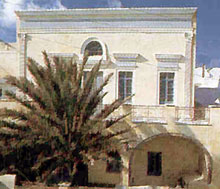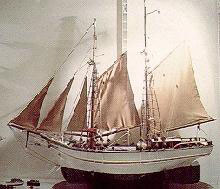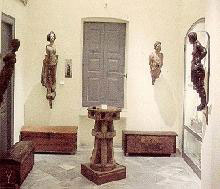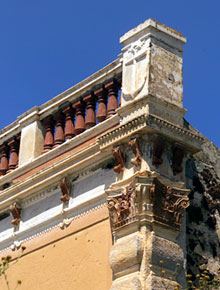Santorini
Culture & Tradition :
santorini churches, greek orthodox easter, religious calendars and festivals, greek namedays, recipes...
archaeological museum, prehistoric museum, megaro gyzi museum, naval museum, george emmanuel argyros mansion, lignos folklore museum...
petros m. nomikos conference center, thera wall paintings, art space argyros canava exhibition, 'vanishing santorini' exhibition...
akrotiri excavations, ancient thira...
Santorini History
skaros fortress, castle of agios nikolaos, tower of nimborio, pyrgos castle, akrotiri castle & tower...
|
| Santorini Museums : Naval Maritime Museum |
| In Oia, the picturesque traditional town on the
northwest coast of Santorini, an 19th century mansion has been
restored and converted into a museum that houses the Maritime
History of Thira.
Rare figureheads, Seamens' Chests, old maritime equipment,
carrening drawings and patterns, models of old and new Thiran
ships, acquarelles featuring old sailing vessels as well as
rare photographs and a library, all register year by year
the contribution of the Thirans to the glorious history of
the Hellenic Navy. Oia reached the peak of prosperity in the
late 19th & early 20th century. Its economic prosperity
was based on its merchant fleet which plied trade in the Eastern
Mediterranean, especially from Alexandria to Russia.
Hence the two-story captains houses built on the highest part
of the village which are a reminder of the village's former
affluence ... |
| Hellenic Marine & Thira (Santorini) Island |
| A Brief Historical Memorandum |
| The Hellenic Merchant Marine
development took place from around the middle of the 18th
Century. The Greek merchants had the chance to exploit
the International opportunities due to the vacancy left
by the Anglo-French antagonism in the commercial routes.
Initially as agents and brokers and later on as independent
merchants and seamen, the Greeks were spreading to Eastern
Mediterranean starting mainly from the islands of the
Aegean Sea.
The Russian - Turkish war (1769-1774) and the Russian
expansion in the Black Sea and the commercial privileges
granted to Russia by the treaty of Cioutsouc Kynartzi
(1774) and of Aynali Cavak (1779), had given the possibility
to the Greek ships to raise the Russian Flag during
that era to penetrate to South Russia and Ukraine.
Thus the Greeks little by little established their
Maritime position, trading mostly the surplus agriculture
products (wine, wheat, cotton) and investing in Shipping
Company's and Transportation Trade.
These activities were profitable and the profits were
multiplied as the Greeks took the risk by carrying mostly
wheat. In a very short time the Greek Merchants and
Seamen had made a fortune. On the eve of the French
Revolution (1789) the Greeks reported that they owned
400 vessels.
The Frenchman Pouqueville in 1813 raised their number
to 615 vessels out of which the island of Thira reports
that 32 vessels were owned by the islanders (8th in
line). The vessels had a capacity of 2560 tons, out
of a total of 193,580 tons, with manning crews of 480
persons out of a total of 37,528 persons. They were
armed with 120 cannons out of a total of 5,878 cannons.
With the Greek Revolution of Independence (1821) the
Merchant Navy was converted to a Revolutionary Naval
Force.
After the revolution the only vital section of the
economy was that of the Mercantile Marine and when the
wheat trade dominated the markets the Greeks had the
monopoly in South Russia and the Black Sea. |
| 1850 Showed an Increase in Commercial Activity |
| Trade with Russia, France, Italy, England & Austria |
| Around the year 1850 the island
of Thira shows an increase in commercial activity far
more that the rest of the islands. It trades directly
with Russia. Almost the total wine production was being
exported there. From Russia they loaded cereals, part
of which were discharged on the island and the rest was
transported by the Thiran Merchants towards France, Italy
and England.
It also exported Thiran pumice stone to Austria, but
mainly it supplied the newly established Greek state
for the building of sea ports and hydraulic works. From
Europe it imported porcelain, timber and silverware,
fabrics, cotton, silk, furniture, perfumes, food supplies
and hardware.
Due to the above activities Thira owned vessels of
large tonnage. In 1852 it had 126 vessels of a total
capacity of 1094 tons (smaller than 30 tons each) and
74 vessels of a total capacity of 13.661 tons (larger
than 30 tons each).
|
| Oia Santorini 847 02 Greece |
| Daily 10.00 - 14.00 & 17.00 - 20.00 (Tuesday closed) |
|
|
|





